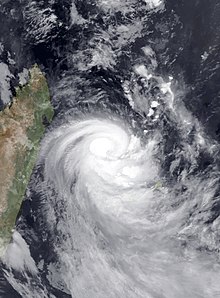 Fakir strengthening east of Madagascar on April 23 | |
| Meteorological history | |
|---|---|
| Formed | 22 April 2018 |
| Post-tropical | 25 April 2018 |
| Dissipated | 26 April 2018 |
| Tropical cyclone | |
| 10-minute sustained (MF) | |
| Highest winds | 130 km/h (80 mph) |
| Highest gusts | 185 km/h (115 mph) |
| Lowest pressure | 975 hPa (mbar); 28.79 inHg |
| Category 1-equivalent tropical cyclone | |
| 1-minute sustained (SSHWS/JTWC) | |
| Highest winds | 140 km/h (85 mph) |
| Lowest pressure | 982 hPa (mbar); 29.00 inHg |
| Overall effects | |
| Fatalities | 2 total |
| Damage | >$17.7 million (2018 USD) |
| Areas affected | Mauritius, Réunion |
| IBTrACS | |
Part of the 2017–18 South-West Indian Ocean cyclone season | |
Tropical Cyclone Fakir was a short-lived yet damaging tropical cyclone that affected Réunion and Mauritius in late April 2018. The eighth tropical system and seventh named storm of the 2017–18 South-West Indian Ocean cyclone season, Fakir originated from an area of disturbed weather that developed north-northeast of Madagascar on 20 April 2018. The system concentrated into a tropical depression by 23 April, and was given the name Fakir later that day. It rapidly intensified while moving quickly south-southeastwards despite the presence of hostile wind shear, and reached its peak intensity early on 24 April, hours before passing just east of Réunion. Fakir succumbed to the wind shear shortly after and weakened as quickly as it had strengthened, becoming a post-tropical cyclone on 25 April. The remnant system decelerated and turned east-northeast while continuing to weaken, and dissipated the next day.
Fakir was the fifth and last in a series of cyclones to affect Réunion in the first half of 2018, after cyclones Ava, Berguitta, Dumazile, and Eliakim. Strong, gusty winds and floods and landslides resulting from heavy rains occurred across Réunion from 25 to 26 April, causing severe damage to agriculture and infrastructure. Schools and businesses were shut ahead of the adverse weather, and flights were delayed at the island's airports. Power lines were blown down or damaged by fallen trees in many areas, resulting in widespread power outages. Water supplies were also disrupted in some areas. Floods and mudslides affected buildings and public facilities all over Réunion, bringing about significant property damage and racking up large repair costs. A mudslide killed two people in L'Étang-Salé. Agriculture was heavily affected, with crops ruined by heavy rains and mudslides and livestock drowned by floodwaters. Total damage in Réunion exceeded €15 million (US$17.7 million). Immediately after the storm, disaster declarations were issued in 15 municipalities and cleanup operations commenced. In the following months, aid was distributed to farmers to help them recoup losses and restart their farms. However, the prices of fruits and vegetables remained elevated up to half a year after Fakir. In nearby Mauritius, cyclone warnings were issued and schools were closed on 24 April. However, impacts were much less severe than in Réunion, being limited to fallen trees, flooded roadways, and mild crop damage.
